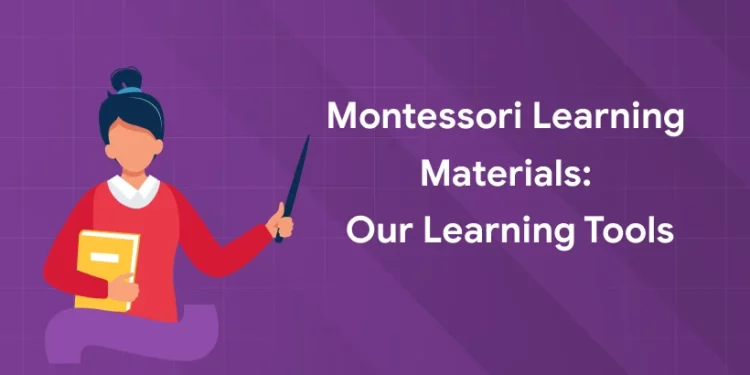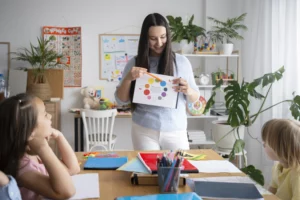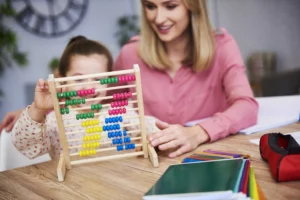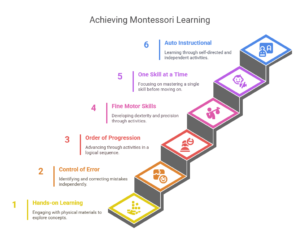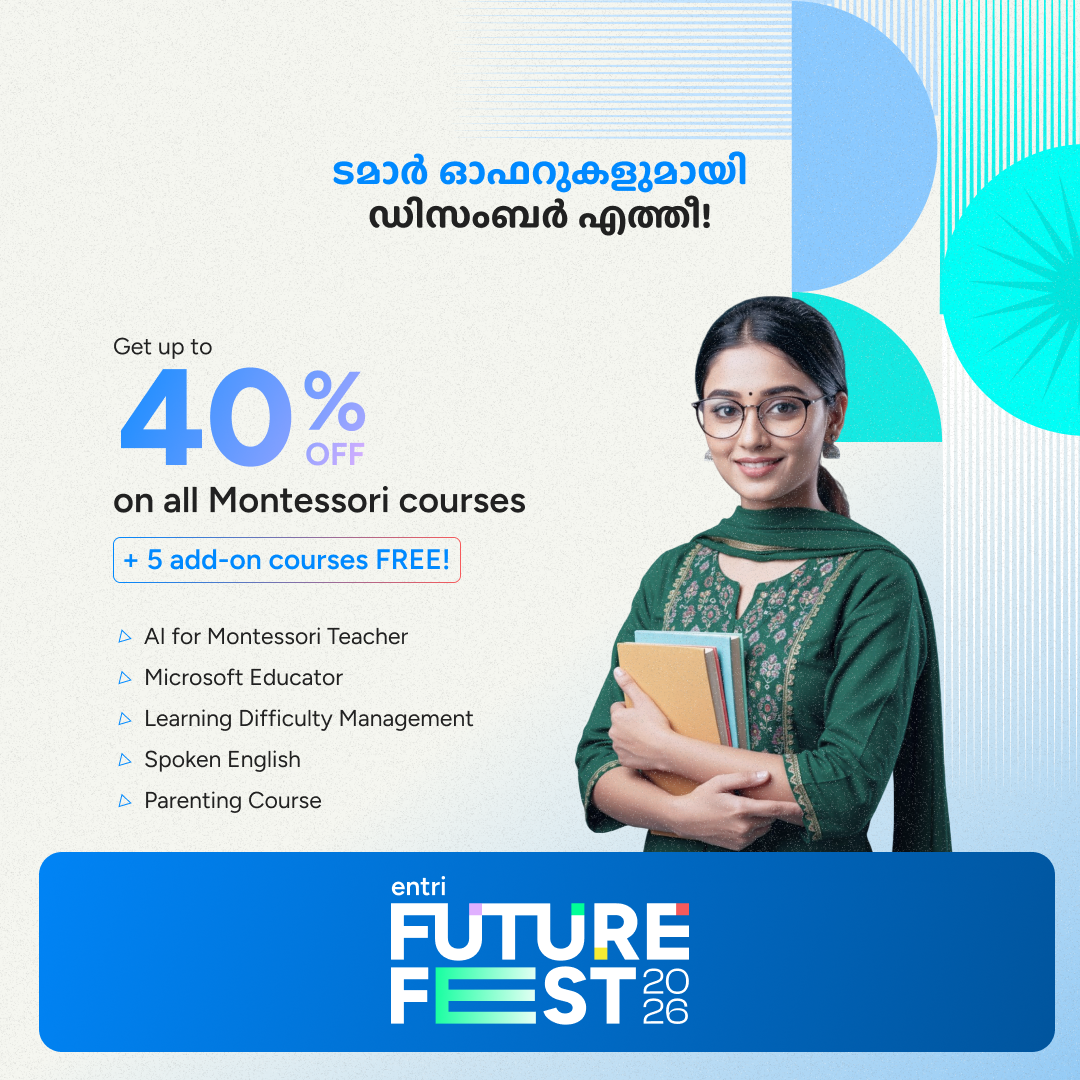Table of Contents
Montessori materials are an educational tool developed by Dr. Maria Montessori in the early 1900s. The materials or manipulatives are designed to be used independently by children, allowing them to learn through exploration and by touch. The materials are designed to be simple and beautiful, emphasizing the sensory experience. They are often made from natural materials such as wood, metal or fabric and are specifically designed to meet the needs at different stages of a child’s development.
Materials are intended to encourage children to learn through self-exploration and discovery when presented or given lessons by teachers. They play an essential role in the Montessori educational method and are an important part of the Montessori curriculum.
Montessori materials represent a departure from traditional education. As such, students may have difficulty adapting to this style of learning with the material as they grow older.
Unlock your passion for education and shape young minds as a Montessori teacher!
Sensorial / Practical Life Montessori Materials
- Red bars – help students understand length, while other dimensions such as height, width and color remain the same. There are 10 wooden bars ranging in size from 10 cm to 100 cm.
- The Pink Tower – the pink tower is one of the most famous Montessori teaching materials. The large pink structure is aesthetically pleasing and helps students understand three-dimensional size concepts, from smallest to largest, preparing them for mathematical concepts.
- Cylindrical Block – teaches children to visually distinguish from different size angles; They have a smooth satin finish on the rounded edges that help fingers grip the pencil.
- Soundbox – helps students develop auditory discrimination across a series of sounds
- Real life materials – features a number of real life materials covering four sub-areas (self-care, care environment, movement, grace and politeness), including Frame Buttons and Zippers (see below) help children develop independence in activities of daily living. These materials are integrated into skills such as dressing, personal hygiene, food preparation (i.e. pouring, cutting, presenting meals), as well as cleaning up after use, returning items return to their old positions and arrange them.
Mathematics Montessori Materials
1: What is the primary focus of the first plane of development in the Montessori method?
Many materials are compatible between materials. For example, some of the sensory materials above are related to math. Other math manipulatives include:
- Golden beads – beads that help students become familiar with the decimal system provide a concrete representation of the hierarchical ordering of numbers.
- Rosary – This is the preparation for multiplication. The numbers 1 to 9 have a multiple identity sequence.
- Checkerboard – This board is used for long and short multiplications in accordance with the hierarchy of the decimal system.
- Rack & Tubes – Developed from Dr. Montessori’s experience as a physician, it is sometimes called the “Test Tube Rack” and helps teach long division.
- Binomial cube – This is a concrete representation of the algebraic equation (a+b)3 and the factors of the equation are represented as cubes and prisms. When first introduced to this material, many parents often say: “If only their children learned algebra that way!
Materials used to directly teach a concept. Students focus deeply on the concepts they are learning. Indirectly, the brain is also stimulated by the senses and therefore Montessori materials attract more parts of the brain, helping students understand and remember information more easily.
Unlock your passion for education and shape young minds as a Montessori teacher!
Get Certified & Start Your Montessori Career
Montessori Teacher Training Course by Entri App: Gain expert skills, earn certification, and kickstart your teaching career.
Join Now!English and Language Montessori Materials
Montessori materials are also easily used to support language and social studies. Below we see five more Montessori materials that are simply designed but highly effective.
- Sandpaper Letters – Helps recognize writing direction very accurately.
- Metal Inserts – This material enhances pincer grip and wrist movement to refine writing, and it also aids in lightness of touch and uniformity of pressure when drawing.
- The Farm – This resource introduces nouns, articles, adjectives and verbs for deeper grammar teaching.
- Sentence Analysis Chart – This document shows the parts of a sentence, including subject, predicate, and direct object. Circles and arrows are objects that guide sentence analysis.
- Grammar Boxes – These activities help students analyze grammar and develop expository reading abilities.
Geography/History/Science Montessori Materials
Below we can see some of the materials that were made to teach these subjects.
- Land and Water Shapes – These shapes are specifically designed to teach children about geography, topography and earth science by working with the senses.
- PuzzleMaps – Puzzle maps are used to teach geography, world culture, and history. They show the shape and size of different countries and continents, as well as their location relative to other countries and regions. Puzzle cards also help children develop visual discrimination skills, hand-eye coordination, spatial awareness as well as names of countries, borders, capitals.
- MontessoriTimeline – They are used to learn about the order and sequence of historical events, as well as to develop an understanding of changes over time. Timelines help students visualize the relationships between different historical events and periods, and understand how people fit into the bigger historical picture.
- MontessoriStories – This is a series of five epic stories that encourage children to think and understand the interconnectedness of all living things and the universe, while supporting an integrated curriculum.
- Atom Quiz – This allows students to see the structure of the atom realistically and understand how electrons, protons, and neutrons are arranged in different atoms.
The Arts
Montessori cultural materials, such as geography and history materials, can also be used to teach children the arts of different cultures. For example, children can learn about music, dance, food and visual arts, then create their own works of art related to these cultures. Children can explore different ways to move their bodies and express themselves through dance and movement, increasing their creativity, fine motor skills and appreciation of art. By providing an experiential and hands-on learning environment, Montessori classrooms can help children develop a lifelong love of the arts.
Arts include the following:
- 3-Part Card – 3-Part Montessori Card can be used to teach children about a variety of topics, from animals and plants to geography, culture and art. Using 3-part cards, children can explore the world around them in a practical and engaging way, using labels, images and text related to the topic.
- Artist Studies – As children progress in their art studies, they have the opportunity to focus more deeply on the work of specific artists. They can learn about each artist’s life and work and can be encouraged to analyze and interpret their work. At CMS, students have the opportunity to create artwork inspired by the work of the artists they study. Below we see students in class 3A testing out a piece inspired by Japanese artist Yayoi Kusama’s “The Erase Room.
- Arts Gala – To experience a live arts event, including art creation, event planning, ticket sales and invitations, our 3rd grade students host an annual Arts Gala inviting Parents and community members attend.
- Role Play – In Montessori, role play serves a specific purpose for young children in learning the rules of the classroom (grace and politeness). Children have the opportunity to engage in imaginative play and play out different roles and scenarios. This type of play helps children develop important social and emotional skills, such as empathy, cooperation, and communication.
- Media Arts – Experimentation with modern media is also encouraged at CMS and students have the opportunity to create their own films, photographs and digital media projects. They may have the opportunity to work with different types of equipment and software and may be encouraged to explore different styles and approaches to media arts.
Get Certified & Start Your Montessori Career
Montessori Teacher Training Course by Entri App: Gain expert skills, earn certification, and kickstart your teaching career.
Join Now!How Do Montessori Materials Work?
-
Hands-on learning
Montessori materials are a hands-on learning tool that guides children to discover important learning outcomes through repetition and practice. Each resource breaks down an important concept into simple steps that children can master through hands-on exploration. This aspect makes Montessori materials especially effective because it involves the hands as well as the mind in every learning experience.
-
Control of Error
Montessori materials are designed with built-in “error control” as a matter of course. This quality allows children to see their mistakes and discover their learning independently through repetition and practice.
For example, the button post is not inserted into the wrong hole, water may spill on the table, or there are too many/too few objects at the end of the counting activity.
-
Order of progression
In the Montessori classroom, Montessori materials are arranged within the curriculum and are displayed from left to right in order of progression, from easiest to most difficult. This logical sequence provides children with a clear learning path as they progress through the Montessori curriculum.
-
Fine motor skills
Montessori materials encourage purposeful movement and exploration. This manipulative quality makes them very useful for developing fine motor skills. These skills are essential parts of a balanced approach to early childhood education. This is because they encourage independence and concentration and prepare children for real life.
-
One Skill at a Time
Montessori materials teach only one skill or concept at a time. This allows children to engage deeply with the material while exploring, practicing, and mastering learning outcomes at their own pace. Each material is developed within the context of all the others to gradually develop children’s knowledge and skills in each area.
-
Auto Instructional
Montessori materials are designed to be used without adult assistance. This helps children discover and master the learning outcomes of each subject through repetition and independent practice.
Unlock your passion for education and shape young minds as a Montessori teacher!
Montessori education materials have the following benefits:
- It provides hands-on learning
- Improves social interaction
- Provides a better learning environment
- It develops soft skills
- It provides independence
This education system allows children to participate Participate in activities, lessons and experiences. This expands their knowledge and helps them grow as individuals. All of this gives students the opportunity to develop their ability to concentrate.
Enhance social interaction
Most Montessori classrooms are integrated with the goal of developing peer groups. This allows children to
- learn from each other,
- talk to each other
- improve life skills such as acceptance and integration.
Learning Environments
Working with older children helps younger children improve their social, communication, leadership and emotional skills. This method is also beneficial for children of all ages.
Soft skills
Several studies have shown that Montessori kindergarten students have better soft skills than other children of the same age. They demonstrate better behavior and are more willing to cooperate and interact with other children.
Independence
Montessori education instills a sense of confidence and creativity. It promotes students’ knowledge and skills such as self-confidence, freedom and confidence in their abilities. Montessori education teaches students the ability to manage and think freely.
| Also Read | |
| Practical Life Tools Creation Project | |
| Montessori Pink Tower Making | |
| Knobbed Cylinders in Montessori | |
| Montessori Red Rods |
Get Certified & Start Your Montessori Career
Montessori Teacher Training Course by Entri App: Gain expert skills, earn certification, and kickstart your teaching career.
Join Now!Frequently Asked Questions
1. What are Montessori materials?
Ans: Montessori materials are educational tools designed by Dr. Maria Montessori to help children learn through hands-on exploration and sensory experiences. They are often made of natural materials like wood, metal, and fabric to encourage independent learning.
2. How do Montessori materials support learning?
Ans: Montessori materials are designed to break down complex concepts into simple, tangible steps. They involve hands-on engagement, repetition, and independent discovery, making it easier for children to understand and remember information.
3. What are some examples of Montessori materials?
Ans: Some common Montessori materials include:
- Sensorial/Practical Life: Pink Tower, Red Bars, Soundbox
- Mathematics: Golden Beads, Binomial Cube, Checkerboard
- Language: Sandpaper Letters, Metal Insets, Grammar Boxes
- Geography & Science: Puzzle Maps, Montessori Timeline, Land & Water Forms
- Arts: 3-Part Cards, Artist Studies, Role Play
4. How do Montessori materials develop independence?
Ans: Montessori materials are self-correcting, meaning children can identify and fix mistakes on their own without direct adult intervention. This encourages self-reliance, confidence, and critical thinking.


